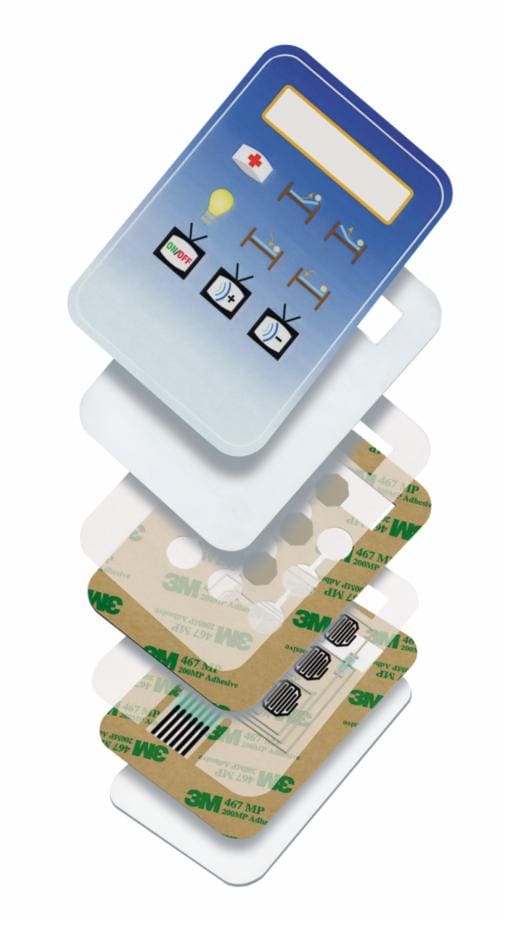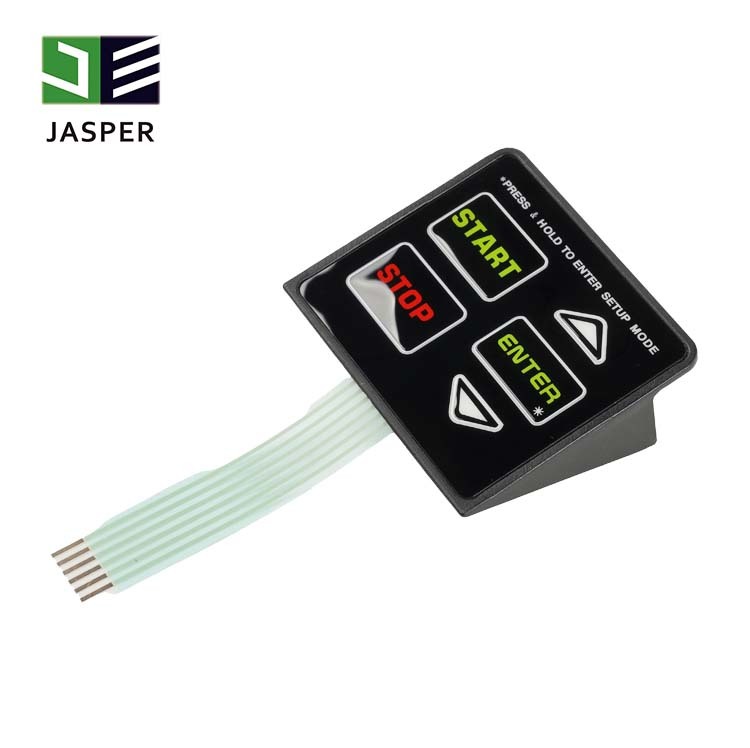Top benefits to use membrane switch in next-gen devices
All Concerning Membrane layer Switch: A Comprehensive Guide for Beginners
Membrane buttons are vital parts in modern-day electronics, offering a distinct user interface for individual interaction - membrane switch. Their layered building and construction, consisting of overlays and conductive traces, gives functionality and resilience. Unlike traditional mechanical buttons, membrane layer switches offer a smooth style and adjustable alternatives. Recognizing their essential attributes and benefits can transform product design. Nevertheless, the ins and outs of their application and layout factors to consider call for more expedition
What Is a Membrane layer Switch?
A membrane layer button is a kind of electric button that contains an adaptable membrane layer layered over a printed circuit card. This design permits for a small and streamlined user interface, frequently used in numerous digital gadgets. Membrane switches are generally discovered in consumer devices, medical tools, and industrial equipment due to their durability and resistance to environmental factors.The construction usually consists of multiple layers, such as graphic overlays and adhesive support, which give responsive comments and secure the wiring underneath. The operation of a membrane switch is launched when stress is applied to the surface area, completing an electric circuit.These buttons are valued for their versatility, enabling custom-made layouts and printed graphics that deal with certain interface. Their inconspicuous nature decreases space demands, making them ideal for applications where traditional switches might not fit. Generally, membrane switches provide a useful and visual solution for modern digital devices.
Trick Components of Membrane Layer Switches Over
Membrane switches over consist of a number of crucial parts that add to their functionality and performance. The top layer, called the overlay, gives the interface and is typically published with graphics or icons. Under the overlay lies a spacer layer, which divides the conductive aspects and prevents unintended activation. The next important part is the visuals layer, which improves visual appeals and assures the toughness of the design.Conductive traces, commonly made from products like silver or carbon, are printed on the circuit layer. When pressure is put on the overlay, these traces enter into contact, finishing the circuit. Additionally, a backing layer offers structural support and can be made from materials such as polyester or polycarbonate. Together, these parts produce a trustworthy, straightforward user interface ideal for various applications, from household home appliances to commercial devices. Comprehending these components is important for any person curious about membrane button modern technology.
Just How Membrane Layer Changes Job
Comprehending how membrane switches over function is crucial for valuing their prevalent usage in numerous devices. A membrane button runs with a series of layers, including a visuals overlay, spacer, and a circuit layer. When pressure is used to the overlay, it compresses the spacer layer, allowing the circuit layer to make contact and complete an electrical circuit. This action sends a signal to the tool, prompting a feedback, such as switching on a light or triggering a function.Membrane switches over can be developed with different attributes, including responsive feedback, backlighting, and custom graphics, improving user communication. Their building and construction permits a closed design, safeguarding the interior elements from dirt, wetness, and pollutants. This durability makes them suitable for varied applications, from customer electronics to industrial devices. Overall, the simplicity and effectiveness of membrane switches over add to their popularity in modern innovation.
Benefits of Membrane Layer Switches Over Mechanical Switches
While mechanical switches have actually long been a staple in several tools, membrane layer switches over deal unique advantages that make them increasingly appealing. One significant advantage is their slim account, permitting for more portable layouts and better adaptability in product development. Furthermore, membrane switches over function a consistent surface, which boosts visual charm and simplifies cleaning, making them ideal for settings where health is critical.Another advantage is their resistance to dust and wetness. Unlike mechanical switches, which can be compromised by ecological elements, membrane layer buttons offer a sealed user interface that safeguards versus pollutants - membrane switch. Membrane buttons normally have a longer life expectancy due to less moving components, resulting in improved toughness and reliability.Cost-effectiveness is likewise a remarkable benefit, as membrane layer switches can be generated in bulk with reduced manufacturing expenses. These aspects combine to position membrane layer buttons as a useful alternative to traditional mechanical choices in numerous applications
Usual Applications of Membrane Layer Switches Over
Membrane switches are commonly made use of in different fields, particularly in consumer electronics and industrial control board. In consumer gadgets, they supply a streamlined, easy to use user interface, while in commercial settings, they enhance longevity and performance. Recognizing these applications highlights the versatility and practicality of membrane switches in modern technology.
Consumer Electronics Gadgets
As consumer electronics remain to progress, membrane layer buttons have ended up being a prominent option for a range of gadgets as a result of their convenience and sleek design. These switches are commonly discovered in mobile phones, tablets, and push-button controls, where area is minimal and aesthetic appeals issue. Their low profile and customizable styles enable makers to produce easy to use interfaces that improve the general individual experience. Additionally, membrane buttons are often made use of in appliances such as microwaves and coffee machine, supplying instinctive control alternatives while resisting moisture and dust. The durability and integrity of membrane switches over make them ideal for daily consumer products, making certain durability and regular performance. In general, their combination in customer learn the facts here now electronic devices mirrors a blend of functionality and modern layout.
Industrial Control Panels
The applications of membrane switches prolong beyond customer electronics, locating considerable usage in commercial control board. These buttons are favored for their sturdiness and resistance to rough settings, making them ideal for making and procedure control setups. They offer a trusted user interface for drivers to control equipment, screen processes, and adjust setups. Membrane layer switches can be customized to suit specific operational demands, incorporating functions like backlighting and responsive feedback, improving individual experience. Their inconspicuous style permits combination into various tools, while their ability to hold up against spills, dirt, and severe temperature levels assurances long life. On the whole, membrane switches add to safe and efficient operation in commercial applications, demonstrating their versatility and efficiency popular settings.
Factors To Consider for Creating Membrane Layer Switches
When creating membrane buttons, selecting the appropriate products is important to guarantee longevity and functionality. In addition, understanding layer configuration strategies can substantially affect the button's efficiency and individual experience. These factors to consider play a vital duty in producing reliable and trusted membrane button designs.
Product Choice Significance
Material choice plays an essential duty in the style and capability of membrane layer switches. The picked products directly affect the button's durability, responsive feedback, and general aesthetic. Trick factors to consider consist of the substratum, which must offer architectural integrity while allowing for flexibility, and the graphic overlay, which needs to be resistant to wear and environmental elements. Conductive products need to assure reliable electrical efficiency, while adhesives need to provide strong bonding without endangering the button's procedure. Furthermore, compatibility with manufacturing procedures and end-user environments is important; products must stand up to differing temperature levels, humidity degrees, and chemical direct exposure. Inevitably, suitable product selection not only improves the membrane button's efficiency yet additionally adds to its longevity and user contentment, making it a vital facet of the layout process.

Layer Setup Strategies

Often Asked Questions
The Length Of Time Do Membrane Layer Switches Over Usually Last?
Membrane layer buttons generally have a life expectancy of 1 to 5 million cycles, depending on usage and ecological problems. Factors such as layout high quality and operating frequency greatly influence their learn this here now resilience and total efficiency longevity.

Can Membrane Layer Switches Over Be Customized for Details Styles?
Membrane layer switches can undoubtedly be personalized to fit particular styles, enabling diverse shapes, colors, and functionalities. This convenience allows makers to tailor these buttons to meet one-of-a-kind visual and functional requirements effectively.
What Products Are Used in Membrane Layer Switch Over Building And Construction?
Membrane switches are normally created using products such as polyester, polycarbonate, and adhesive layers. These materials offer resilience, versatility, and resistance to environmental elements, guaranteeing the buttons operate properly in various applications and conditions.
Are Membrane Switches Immune or waterproof to Dampness?
Membrane layer buttons can be developed to be moisture-resistant, using specialized finishes and materials. Their water-proof abilities depend on building and construction top quality and certain applications, making it vital to evaluate needs for perfect efficiency in different environments.
Just How Are Membrane Layer Switches Fixed if Harmed?
Repairing damaged membrane switches over generally entails changing the influenced layer or circuit. Specialists may also use conductive glue or use specialized fixing kits, ensuring performance next is brought back without total substitute of the entire button setting up. Unlike conventional mechanical switches, membrane buttons present a streamlined design and customizable alternatives. A membrane switch is a type of electrical button that is composed of an adaptable membrane layer layered over a published circuit board. The operation of a membrane button is started when stress is used to the surface, finishing an electrical circuit.These buttons are valued for their convenience, enabling personalized styles and printed graphics that provide to certain individual interfaces. While mechanical switches have long been a staple in lots of gadgets, membrane switches offer distinct benefits that make them significantly appealing. Membrane layer buttons generally have a longer lifespan due to fewer moving components, resulting in boosted durability and reliability.Cost-effectiveness is additionally a significant advantage, as membrane layer buttons can be generated in bulk with lower production costs.